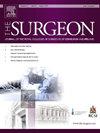髋关节和膝关节人工关节置换术术前CT计划扫描意外发现的发生率和临床意义。
IF 2.3
4区 医学
Q2 SURGERY
Surgeon-Journal of the Royal Colleges of Surgeons of Edinburgh and Ireland
Pub Date : 2025-04-17
DOI:10.1016/j.surge.2025.04.002
引用次数: 0
摘要
目的:髋关节和膝关节机器人置换术术前计算机断层扫描(CT)计划扫描中发现的偶然发现的发生率和临床意义存在争议。本研究旨在在单个髋关节和膝关节置换术单元内确定这一点。方法:回顾性队列研究对所有在我院接受髋关节或膝关节置换术CT计划扫描的患者进行了30个月的研究(2021年12月- 2024年5月)。回顾了CT扫描报告,并记录了偶然发现。偶然发现由独立审稿人分为三类之一:不需要采取行动,可考虑采取进一步行动,需要采取紧急行动,例如潜在的恶性肿瘤。结果:在30个月内确定了1452例CT关节置换术计划扫描。48例(3.3%)病例未提供放射科医生报告,其余1404例(96.7%)可作进一步分析。注意到592例(42.2%)偶然发现,其中244例(17.4%)被分级为可考虑进一步行动,16例(1.1%)需要紧急行动。所有确定需要采取紧急行动的患者都得到了适当的管理。结论:术前CT关节置换术计划扫描意外发现发生率高(N = 592, 42.2%),其中大多数不需要进一步处理。相当大比例(N = 244,17.4%)的扫描有可能考虑采取进一步行动的偶然发现,而一小部分(N = 16,1.1%)的偶然发现需要采取紧急行动。术前CT计划扫描应由放射科医生报告,因为重要的偶然发现的发生率很高。本文章由计算机程序翻译,如有差异,请以英文原文为准。
The incidence and clinical significance of incidental findings seen on pre-operative CT planning scans for hip and knee robotic arthroplasty surgery
Aim
The incidence and clinical significance of incidental findings identified on preoperative computerised tomography (CT) planning scans for hip and knee robotic arthroplasty is disputed. This study aimed to determine this within a single hip and knee arthroplasty unit.
Methods
A retrospective cohort study was performed for all patients that underwent CT planning scans for hip or knee arthroplasty at our institution over a 30-month period (Dec 2021–May 2024). CT scan reports were reviewed and incidental findings noted. Incidental findings were graded by independent reviewers into one of three categories: no action required, further action may be considered, urgent action required e.g. potential malignancy.
Results
1452 CT arthroplasty planning scans were identified over a 30-month period. A radiologist report was not provided in 48 (3.3 %) cases, leaving 1404 (96.7 %) available for further analysis. 592 (42.2 %) incidental findings were noted, of which 244 (17.4 %) were graded further action may be considered and 16 (1.1 %) urgent action required. All patients identified as urgent action required received appropriate management.
Conclusion
Pre-operative CT arthroplasty planning scans have a high incidence (N = 592, 42.2 %) of incidental findings, most of which most require no further management. A significant proportion (N = 244, 17.4 %) of scans have incidental findings for which further action may be considered, whilst a small proportion (N = 16, 1.1 %) have incidental findings for which urgent action is required. Pre-operative CT planning scans should be reported by a radiologist due to the high incidence of significant incidental findings.
求助全文
通过发布文献求助,成功后即可免费获取论文全文。
去求助
来源期刊
CiteScore
4.40
自引率
0.00%
发文量
158
审稿时长
6-12 weeks
期刊介绍:
Since its establishment in 2003, The Surgeon has established itself as one of the leading multidisciplinary surgical titles, both in print and online. The Surgeon is published for the worldwide surgical and dental communities. The goal of the Journal is to achieve wider national and international recognition, through a commitment to excellence in original research. In addition, both Colleges see the Journal as an important educational service, and consequently there is a particular focus on post-graduate development. Much of our educational role will continue to be achieved through publishing expanded review articles by leaders in their field.
Articles in related areas to surgery and dentistry, such as healthcare management and education, are also welcomed. We aim to educate, entertain, give insight into new surgical techniques and technology, and provide a forum for debate and discussion.

 求助内容:
求助内容: 应助结果提醒方式:
应助结果提醒方式:


